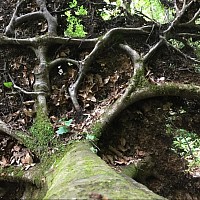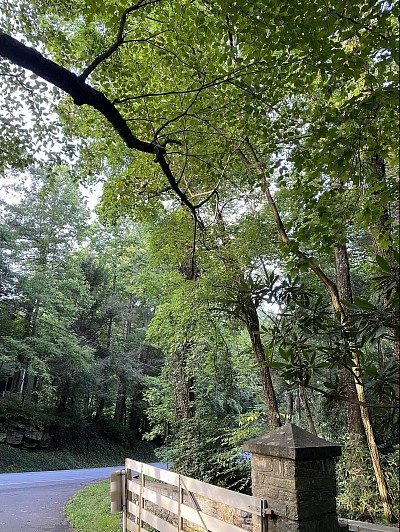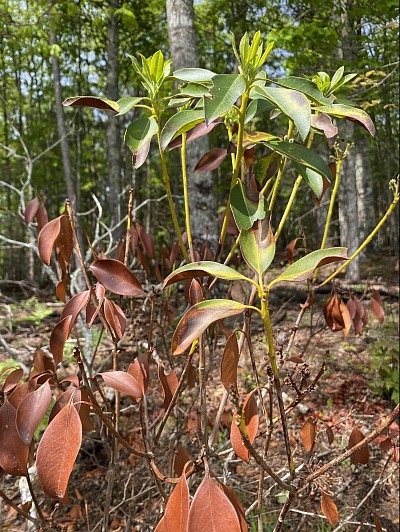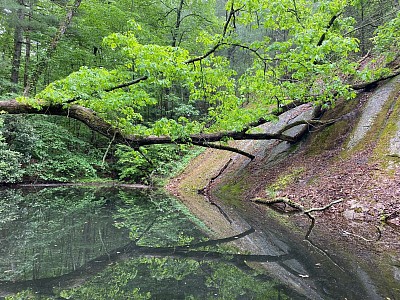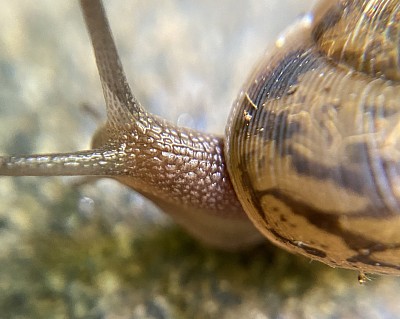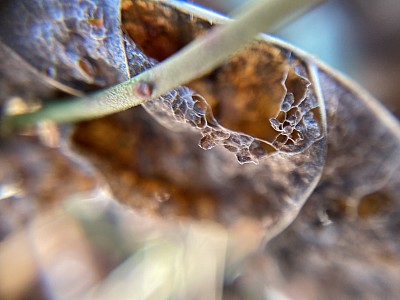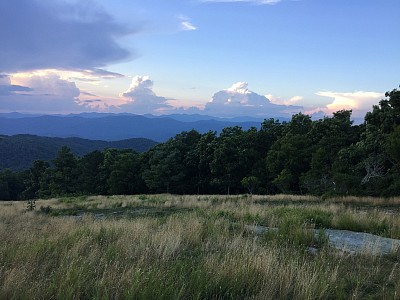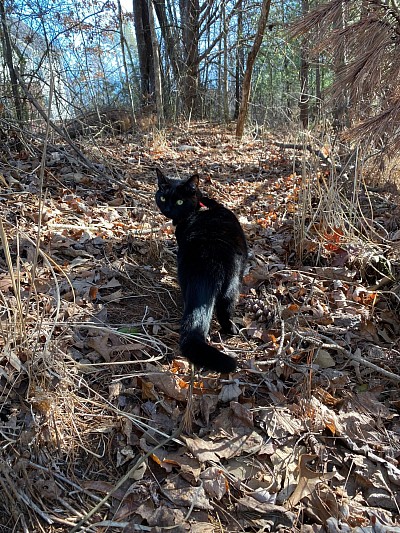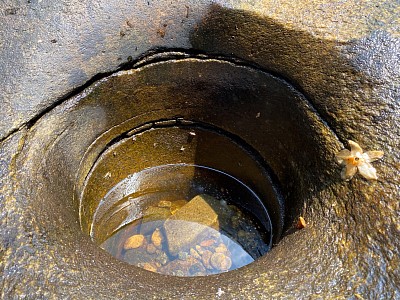Nature Healing Rambles
Song of Seeking
I search for myself often in the wildness of the world,
in the quiet of slow footsteps.
I search for myself in the smell of honeysuckle
in the spring by the pond.
In the flight of red-winged blackbirds
and the submersion of snapping turtles,
In the opening blue of morning sky
and the shutting eye of mountain-vast horizon.
I search for myself in the settling of my breath
when I'm alone by the river.
I search for myself in the bark of tulip poplars, beech and birch.
I search for myself in the minute undulations of leaves,
the hiding places of turkey tail mushrooms,
the opening of laurel flowers.
There, I find myself.
In the way my hand opens on its own and reaches out to the air,
I find myself. In the cold clasp of a rushing creek at my ankles.
In the softening of my eyes around an image of a silent heron wading,
patient and undaunted, I find myself.
In the touch of your hand to my hand
and all the glorious green-filled
distance between us, in the place we live, I find myself.
In the silence of stars and the calls of peepers,
in the feel of earth where I stand,
in the way my belly lets down as I find myself alone
among the rooted giants, I find myself.
In love with life, I find myself.
The Hidden Magic of Close Places
The romantic adventurer part of me can't wait to jump in the car to head out to some vast and distant nature escape with water bottles, protein bars and the whole day ahead of me. If I'm tired or pressed for time, a nearby park or local patch of woods seems like just a consolation. But often I find myself receiving particular gifts from those more common green spaces and they feel like familiar friends who, when I'm wise and settled, I crave most of all.
I should mention that here in western North Carolina where the Blue Ridge mountains are as biodiverse as any place on Earth, even the local parks are filled with natural wonders. Close places around here often have ponds, the best ecosystems to easily catch a glimpse at wildlife. Ponds near here are home to tons of animals and you know when you visit frequently that you're probably seeing the same individuals.
Newts suspend strangely in calm water. Salamanders of many varieties slither in moist leaves. Snakes bask on warm rocks. Bream clear debris from the pond bottom to make their sandy nests. Trout surface for insect snacks. The throats of huge bullfrogs bulge out their songs in a gritty baritone and tiny peepers sing in a rhythmic symphony. Their loud calls can lead you to them. Snapping turtles disrupt the stillness of lily pads and wait in quiet murky waters while red-eared sliders line up on fallen branches.
Above, ospreys glide and perch, and in the shallows great blue herons wade slowly, leaving tracks in the mud with giant toes. Red-winged blackbirds sing in river birches, and geese and ducks raise their fuzzy babies. Hollow snags reverberate with the drumming of black, white and red woodpeckers from the tiny downy to the large pileated. Sometimes a raccoon can be seen sitting on a rock and leaning over the water, waiting for a fish. Otters raise their heads, then show their slick fur as they dive back under.
There's nothing as calming and happy for me as getting to see wild animals simply living their lives. It fills me with joy and the sense that I'm connected in the blur of movement and appetite that is life. I think this is a universally reported experience. It's fun to be a spy in the world of wildlife, watching each fascinating drama unfold. And even if the local pond or end-of-the-road grove or river along the rails-to-trail isn't busy with wildlife on a particular day, there are still always secret wonders to stumble on. Spider webs floating on the tops of waving grass, morning dew sparkling, spooky fog, squirrels taking a long jump, missing, falling, bounding right back up another trunk.
Throughout the spring and summer, the fashion show of wildflowers offers constant change to any green space. The leafing out of summer trees that change to reds, golds, purples in the fall, shed into crunchy carpets before reappearing tiny and soft in the spring. Even the same old places, comfortingly cozy, are always changing their clothes. And we get to feel the rhythm of that cycling in ourselves and experience the return of wild old friends.
Building these kinds of ongoing relationships with places we visit again and again deeply supports our brains, bodies and souls. Touching in with the beings who live there, and discovering what new developments are unfolding keeps us grounded to a sense of place, a nearly-lost human need. The sense of belonging to where we live, showing up to wander, observe or simply be, compassionately witnessing all who live there, is a vital ingredient in our own sense of safety in the world. We reach out with our awareness to feel the network all around us, connecting and holding us. There's the sense that we're invited, welcome, part of a community greater than humanity. Suddenly we make sense.
I believe this kind of belonging connects to our deepest most essential attachment needs, possibly just as powerful as the attachment we feel to our closest people. For those who feel more safe, accepted and at home in nature than they do with other humans, tending this kind of relationship with a close natural space is crucial and potentially the first key ingredient to healing relational wounding.
This kind of relating is a practice I highly recommend. Try identifying somewhere nearby that's accessible where you can walk, sit on a bench, wade in a stream or dangle your feet over a river. Maybe it's your backyard. Go there often, and let yourself spend time, sink into the unique vibe of that place, looking around at every changing detail. Let it work its magic on you, tracking your body for little signs of settling: easier breath, more ability to focus, softened shoulders, quieter mind.
As you hang out with this new friend more and more, that sense of safety begins to build. Soon you'll crave it, find more and more time to visit, begin to let down, feel easier, breathe fuller even before you arrive. This is the core practice, I believe, in learning to truly connect to the natural world within and without. As you practice showing up again and again, building that bond with your place, you also build a bond with yourself and the person in you who emerges into a space of love and appreciation for what's right there all around you.
Reclaimed
A couple days ago I drove out to a spot I love at the edge of Dupont State Forest (The land was purchased from the chemical company). Carefully winding up the furrowed gravel road to the top, I parked beside a metal gate and walked out through a field carpeted with red flowers growing in rows too perfect to be wild, a vestige of the clearing’s former life. On the other side of the field, the trail passed an over-seasoned wood pile and out into a hidden wonderland of lichen-decorated exposed granite, pitch pine and young woods.
Since a recent prescribed burn to clear out available fuel for potential wildfires, the ground was sparsely covered and the oaks and sourwoods seemed even more spaced apart. Fresh green burst from the browned tops of young laurels, mountain blueberry bushes reasserted their floorspace and the delicious smell of toasted pine sap filled the air. With less underbrush, this welcoming place felt even more accessible, calling me to wander. Dropping more and more evenly into my body, my awareness reached out around me, feeling the palpable solitude and the rocky ground. I climbed moss-covered boulders and studied the skeletal remains of charred deadfall. Running my fingers across the braille surface of the granite slopes, I longed to read the hidden story of its life before human possession.
After exploring the boulder playground, I sat on a rock and appreciated the little mountaintop and how secure I felt inside its quiet beauty, as though there was nowhere else to get to and nothing more important to do. Despite recent logging, obvious farming and various forms of fire intervention, this beat-up place was still natural enough for me. And despite the rocky crunch of cars on the nearby road, it was as sacred a place as I’m going to get within thirty five minutes of home. Gratitude warmed through my core.
I first learned the land-use term "open space" as a fledgling journalist reporting at the New Jersey State House. Open space, as Christine Whitman advocated in the late nineties, designated land to be protected from further development. It wasn't set aside for environmental reasons alone, but for human recreation. However, the impression that stayed with me, whether or not it was true, was the intention to let these places be themselves without further human interference.
There was something about imagining green spaces, whether reclaimed agricultural areas full of overgrown, weedy, brambly scrubbiness or deep mushroom-growing, big-log-decomposing, bear-wandering old growth forest, that called my heart. And I, like cramped little New Jersey, sorely needed it. Open space became a symbol for me of the soul, the core aspect of our multi-layered being that's wild, free and moves from its own sense of purpose. Maybe it's a romantic dream for a human to fully function from that place, but the earth once lived it.
Over the years of my own reclaiming process, the symbol of open space stayed with me. In my mind, I saw a field of long grass, a few trees: a place that had been deforested, over-farmed and then abandoned. So much of our country exists in this state. But to me, the promise of regrowth was present in the image of that field. There, the invisibly slow process of seeding and rain and summer sun unfolded. It was a big space and if you stood in the middle of it, you couldn't see the edges. So it could be endless, really.
For years, when I've needed to slow down or soothe my nervous system, the spirit of that image comes to me in the form of whatever natural space I've visited recently or that I crave or that somehow intuitively visits me, quietly reminding me of its magic. It brings the flush of warm relief to my body, the unmistakable feeling of safety and the heart-swell of coming home. It could be a nearby creek or a vast New Mexico desert. Whatever the image, the satisfying sigh of nature connection is what I associate with reclaiming the soul or the "Self," the part of us that no one can buy and we can't sell.
When human life crowds in on me, or the old puritan voices in my brain are getting too loud (telling me to be more productive, more useful, more giving to others, more careful and frugal and constrained), I call in the spirit of these places. I need in those moments to find the open space preserve that is me. To claim open space for myself, let it take its own course, move at its own pace, mark its own boundaries, form itself to be as it was meant to be, not as others want to make it. This life, after all, doesn’t belong to that chatty bossy part of myself. Maybe it doesn’t belong to me at all.
This week I’ve returned in my memory to that hilltop once owned by a chemical company, feeling the delicious freedom of its relative wildness, smelling the burned pine needles, leaning into the soft earth and feeling through my shoes those acorns, now opened by a flash of heat, ready to grow into themselves.
Beneath
Peering over the railing of the bridge where the Flat Rock Park pond empties into a creek, I spy through the dark water the ghostly form of a big snapping turtle. She rests on the bottom, her face only inches from the surface, strands of mossy green haloing her huge shell. She's bigger than the ones I'd seen here in the last couple years. Does a snapper grow that fast? Her head, wide and pointed, almost triangular, seems alien among the pond fish that swim past her, unaware of the threat. She notices me, and with the perfect graceful slowness of an ancient reptile, her missile-shaped head begins to disappear into the shadow of the bridge.
I watch closely as she submerges, studying through the ripples her ironically tiny face, small round eyes close together and balanced at the tip of her nose. Compared to her huge beak, they seem delicate and mismatched. Her gray skin and shell blend with the sandy muck below, giving her an elusive, otherworldly quality. Hairy green strands flow from her algae-covered back.
That eerie face momentarily fades behind the reflections on the surface, the new spring maple leaves waving above my bent silhouette with its wide-brimmed hat. I refocus my eyes and the images mingle with her pale face, hooded eyes watching me as I stare back. The circle of my hat, the dancing leaves, the sky and this quiet creature of the murk all blend in overlapping undulations. I see myself in the turtle and the turtle in me.
I wonder, can I access the wisdom of her 230-million-year-old legacy in myself, a mere primate? Can I feel her slow, silent movement in my own body, trust the parts of my brain we still share, awakening to spring sunlight, contracting against perceived threat, falling into the stone stillness of one of the most ancient kinds of reptiles? Can I invoke her patience in myself, waiting like an arrow poised until the perfect moment to strike? Such economy of movement, such reliance on the fickle warmth, the drought-starved creek, the flitting fish. So vulnerable, really.
I admire her simplicity, her clarity of purpose, her oneness with the immediate world and it’s immeasurably unfolding moment. I’m fascinated by her, and in my imagination I crawl inside her skin. There, a feeling awareness spreads out, sinks down, reaches inward and outward. Cool liquid, darting shadows, seeking quiet protection. Pure attention riveted to the changing light and darkness overhead and something glittering in the periphery. Listening wordlessly to the waterlogged sounds, swish, creak, slog. Bracing, readying, waiting without time, then releasing, sinking, heavy.
I remember Dave Berger, my Somatic Experiencing teacher describing how to “court the reptilian brain,” the oldest part of the brain that contains the amygdala. Controlling fight or flight responses, the amygdala reacts purely from survival instinct. Powerful and unthinking, its actions move from hundreds of millions of years of learning. Our cognitive decision making is just the whisper of an afterthought compared to that kind of instinctual knowing. To work with this reptilian part of us, calm it, redirect its powerful energy, we have to sink below the primate mind into the world of sensation, attuning to the nervous system’s core impulses, learning its ancient language.
What must it be like to be, as a snapping turtle, so deeply embedded in that knowing? To have no thought-based override? To swim entirely in those pre-cognitive depths?
I can see the long claws of the turtle’s feet as she slowly repositions her body, those muddy toes somehow both frightening and endearing at once. Before long she glides beneath the bridge and though I walk to the other side I don't see her reemerge. She prefers to be hidden.
I walk back along the bank of the pond to where a fallen tree hosts four red-eared sliders sunning in a precarious line on a branch that cuts along the water's surface. I slide quietly, slowly onto a bench beneath a shading pine to watch them. Sometimes they get spooked and torpedo into the water, crawling back up a few minutes later like giant beetles, awkward, balancing their inflexible bodies on a bobbing, rounded perch. There, the turtles languidly soak up the sun, holding in the core of themselves the secrets of trauma healing.
Slowing
Today I need to write about slowness, to be with its draping, languid quality of ooze. There's so much I want to get done today but its not to be. My body is too stuck in the goo, and so I'm going to move along like molasses and find my sleepy way into the inner life of a snail.
Watching one of these small creatures traverse the world is fascinating, even if it is a little bit of yawn. They seem to glide effortlessly, glossing over the surface of the world, their path marked with slime as though to slow down everything behind them. There's such a lack of force in their being, each gentle turn of their head flowing with ease and softness. Chasing one to get a close-up photo isn't so hard. They just move along inside their own boundary, and if they retract, that perfect containment is only part of their charm.
Snails are such a wonderful metaphor for the kind of slimy slow internal physiological movement that happens as we allow ourselves to return to a pace that feels good, that creates healing. As we drop the antenna of our awareness down into our sensory experience, access safety and give ourselves permission to accomplish nothing, we find our way into the ventral vagal aspect of our parasympathetic nervous system. Here we rest and digest, a truly pleasurable place to be.
As the body leans toward ease, the heart slows, organs and muscles, connective tissue, spinal column and really every other inner structure of our biology softly expands just as a snail does when it feels safe, peeking out of its protective shell. Inside us there is a sliding back toward the ground of all the structures that tend to lift up or contract during threat. No more need to seem bigger or smaller, no more need to brace or hide. Welcome back to fluid motion, slow and steady.
So, as our body parts all ease slowly back into place we feel warmer, maybe even a little sleepy, certainly more in contact with what's nearby. We might imagine ourselves moving belly-to-ground like a snake or undulating over a rock on our one out-sized snail foot. And we'd be happy as a turtle to simply sit still in the sun. This easing up is exactly how the nervous system heals from trauma, shifting out of chronic patterns of flight-or-flight, moving slowly and gently out of freeze, the body shifting toward comfort again.
For my nervous system, gaining the capacity to slow down took years and continues to deepen. Even if I wasn't from New Jersey where everyone vibrates with a caffeinated, fast-talking, punchy go-go-go, I'm sure all the layers of trauma and culture and ancestral patterning would be quite enough to keep me buzzing around. So it's no small accomplishment for me, or for lots of folks, to practice this deceptively simple snail skill.
It requires patience. The lives of snails aren't long, but they never seem to be in a rush. They take their sweet time no matter what. As I remember watching one of these little beings maneuver across a rocky trail, I notice the awakening in my chest of appreciation, compassion, maybe a little humor. How unaware that snail was of all the things around that could harm her, and yet she seemed content to inhabit her tiny world, sensing the air, the ground, a fern.
That sense of enough. Happy to be here. I like to remind myself how perfectly enough it is to inhabit my body right now, breathing, expanding, slowing. That I'm enough even when I'm not doing much. That life is enough even when we're not influencing it or keeping tabs on it all. And when we truly rest our brain and body, so much inside begins to happen on its own, patiently reversing a lifetime of rushing and force.
Feel Your Photo
One of the first gateways for me into exploring Nature and falling in love with her was photography. Twenty-five years ago, living in the Santa Cruz Mountains, I began to explore the dusty preserves just above Silicon Valley. These windswept spaces were soulfully inspiring and laden with visual treasures totally foreign to my New Jersey brain. Wandering around with a thirty-five millimeter film camera brought me into direct contact with the beauty of the wildness there.
Photography has a way of attuning you to beauty. The more you're looking for fascinating shapes, high contrast, shades and slants of light, wildlife opportunities and varied textures, the more you become aware of these elements around you and look for them all the time. You're more likely to spot a coyote at dusk or catch a hawk stopping for a moment on a weathered fence post. Nature photography helped awaken in me a keen awareness to the mysterious unfolding of the organic world. I became a natural-beauty junkie.
Wandering along a narrow path, just off the ridge where Highway 35 cuts through the gentle hills and then dives down through redwood forest into the valley, I carried my heavy camera with me, looking for Nature. And she was everywhere. It seemed, even, that she was looking for me. More than once, I had the distinct sense I was being tracked by a mountain lion. I would hear a rustle or get that hair-raising sensation, stop and listen with every cell, searching the dark spaces of woods and grassland for a possible predator. And even when I didn't sense one, I often imagined one. It helped keep me alert and present to my surroundings, I'm sure.
Other than that, though, I felt very at home, learning the trails and taking tons of photos. Bluish lichen, bright yellow banana slugs, iron-colored redwoods all came to me through my lens, touching me with their incredible beauty. Sometimes however, I found myself setting the camera down and simply standing still to smell the air or run my hand over the smooth bark of a twisting manzanita. Sometimes I'd climb into the arms of a moss-covered live oak to take in the surroundings, listen to the crows and rest. Eventually, I found I didn't need the camera to take me out to the natural spaces. I just wanted to be there.
There's so much about experiencing nature that the camera can't capture. Wading into the cold Pacific. The view in all directions from a mudstone cliff above the ocean. The feeling of the wind blowing your hair back like a twisting cypress. And the touch of a sea anemone in a warm tide pool sucking at your finger. Not even words can describe these things. The only way to experience them is to be alive there in that moment and truly listen to the world through your own powerfully-sensing nervous system.
That being said, I would always recommend to anyone interested in photography to take their time in the woods looking everywhere for hidden treasures. Last year my partner bought me a macro lens that clips onto my phone. I was thrilled to be able to finally get some super close-up shots. For months, I dove into the tiniest worlds I could find: the grain of a fallen pine dripping with honey-colored sap, the inner sanctum of a flower, the lacy skeleton of a long-decaying leaf. It was incredible to look at life so close up, to see how the closer you look, the more the forms you recognize turn to shapes and then simple patterns, just as you might look at the universe through an electron microscope.
Becoming a nature photographer can help your somatic practice if you let it slow you down, if you allow the process of looking and seeing to internalize. If you feel the beauty you seek, and really let it in as you capture it with your phone lens. Try it as you walk in the woods or along the coastline or on a glacially-cut rock face. Your attention focuses like your lens, awareness sharpens and begins to take in everything around you. Take moments to stop and bring that strong attention inside to feel the power of the beauty around you and see what happens for you internally.
We can sense our own aliveness the way we sense the movement of water, watching the waves of the ocean washing the sand. We can attune to our breath, heartbeat, muscle tension, relaxing abdomen, wiggling toes the way we watch a tiny bird flit from limb to limb, following with care and fascination, waiting for that perfect photo. After all, our bodies are Nature and it can be thrilling to watch her go about her day right here with us, moving, digesting, aging, growing anxious, settling down, getting sleepy, changing like the tides.
And just as our presence in the natural world changes that world (startling a fox running across the field, attracting a curious hummingbird, padding down the long grass where we cut our own path) our attention to our own body slows us, regulates our systems, creates a space for dissociated experiences to integrate. Over time, the lens of our awareness gets more attuned and our body answers more and more readily to our caring attention. We live more closely with Nature and we begin to feel her loving us back.
Space
There’s a certain ridge trail in the Montreat wilderness, a place with a slope that drops down through sparse woods. With minimal underbrush, I can see the bed of leaves softly blanketing the floor down and down. Looking out across the valley to the far mountain beyond, there’s a sense of deepening space, of the opening around me both vertical and horizontal, the way a bird must feel surveying from a lonely snag at the edge of a cliff. My eyes move from close to distant, drinking in the forms of tall pines, twisting laurels and arching sourwoods as they diminish at the edge of my vision. Listening, the sounds of scurrying feet and distant calls connect near to far, stretching my attention wider and wider. Even without a panoramic view, there’s a sense of vastness in this remote patch of woods. Here, there’s always a deep sigh.
Setting down my trekking poles, I sit on a fallen tree with a smooth, scooping shape and look around, slouching toward the ground. Every treetop I look through, every fold in the mountainside I reach with my awareness helps me feel larger and more fluid, as though my own body is that landscape, vibrantly sensing. I would hate to be truly lost here or to have nowhere that’s home, but there’s a sense of hiddenness that’s truly delicious. For many years, in places of space and solitude I could finally breathe deeply and the part of me so easily overwhelmed by the human world would find its way back to me. There’s something about that openness, the opportunity to energetically spread out that’s so joyful and strengthening to me. It’s an invitation to be fully free, take up space and move with abandon.
I wonder, for people who tend to feel trapped by obligations, schedules and the constant barrage of their own mind, what it would feel like to get to spread their consciousness out into such a vast and beautiful space, to feel the world beckoning in a playful sweet way rather than demanding and corralling. Many people don’t notice they live in that hunched, constricted, furrowed-eyebrow sort of way because it’s so normalized. They might need to sit for a long time on the fallen tree at the edge of the ravine before their attention dares to escape, trickling slowly out into the physical environment. But I think it would eventually happen for anyone patient enough to give it a try. Even after practicing for years, I sometimes have to sit for a while before I get it that it's safe to let down.
I’ve seen plenty of people observe overlooks along the Blue Ridge Parkway, pulling up in their cars, getting out to snap a quick photo, stretch, then get back in and drive away. Like tourists to a place of worship who enter, dab themselves with holy water, glance around and walk out, they don’t stay to worship or be transformed. Many people arrive to natural spaces that way. Maybe they don’t need beckoning space as much as I do, but I suspect they simply aren’t in the practice of feeling a place, of staying long enough or sensing the response in their body enough to let the magic happen.
It takes time to drop in like that, and curiosity, and the gentle returning of attention away from thoughts and back to the sensation of air on skin, the look of that curved hillside, the feeling of energy flow returning. And for most people, it helps to notice that no one's watching, that they don't have to be someone rational, consistent, well-behaved or respectable. They can be someone more real than that.
When we feel safe to be ourselves, we tend to come back to our bodies. As the natural being we are slowly reclaims us back from the tyranny of thought, we start to land. And as we land back in our pelvis, legs, feet, we meet the ground. We make contact. We are suddenly back in relationship with the physical world, aware of things we never noticed before. The ground we touch spreads in all directions, humming with wind-blown grass and bird-rustling brambles, humming with the imperceptible movement of tectonic plates, subterranean streams and slow moving earthworms.
Sitting on that smooth log looking down the long slope where saplings dance in the breeze, I notice how big and full of movement the world really is, how perfect and normal it is to slowly expand. I begin to feel my body echo this expansion. There’s a feeling of warmth and tingling as the cells of my organs and muscles start to wake up more, drink in more energy, thaw, vibrate and release. My lungs grow to take in more air, breathing in the smells of pine resin and decaying leaves. Something emotional opens in my gut, some deep feeling that’s been locked away finally picked up as by a rushing river and carried toward the sea.
In open space I’ve learned that the world is big enough to handle me in my natural state, that natural spaces are places to practice allowing our natural expression, to make sound, dance, sing, make faces, roll around in the dirt or laugh really hard. Sometimes it's easier to do these things in a space free from humans. The trees and squirrels won’t judge us. They don’t think we’re uncivilized. And if we need to sit and cry our eyes out, that makes sense here too.
Body things make sense here, like the cellular knowing of what we need to survive as well as be joyful, and all our instinctual impulses to play, create and connect. These things make sense. In the natural world, full, free, spontaneous life makes sense. For me, it’s worth climbing a steep switch-backed trail through rhododendrons to get to a place of remembering that.
Learning from the Master
I take my cat Fae outside on a leash. I know it's weird, but she loves to be outside and I love to be there to protect her. We don’t walk far. Mostly she sniffs at the edge of the twenty-foot woods and looks around for other cats trying to invade her territory. Sometimes she crouches unmoving for long periods while I stand, feel my feet and stare at the trees. It’s okay. I like that too. In fact, it's incredibly good for me.
When Fae wants to go outside she whines and whines, perfecting the pathos in her tiny voice. I usually end up giving in, walking over to put on my coat and slip the harness over her tiny head as she purrs and tries to get as close to the door as possible. I try to trust her wisdom. Somehow, when I'm the least interested in taking her out, that seems to be when I most need to get my own feet on the earth, feel the fresh air and take a few moments to do nothing.
I get to drop into the amazing practice of grounding. So, while Fae investigates a bird hopping along a low branch or a vole scurrying in the leaf litter, I practice feeling my feet. I look down at the ground and notice it's not as far away as it sometimes feels. It's right there, full of dirt and exposed roots, fallen pine needles and weedy grass. So simple. Just the ground, holding me up. It is, after all, the entire platform for all life, for my life. It's good to come down.
Some of the somatic practices that help me ground have to do with letting my lower body soften, expand and become more present to my brain. Just slowly becoming aware of the sensations in my feet, calves, then thighs allows them to release whatever tension their holding and become friendly again with gravity. Look, legs, it’s the earth! It's got you!
Grounding is a core somatic practice and it can be challenging when there’s a lot of charge, but it’s great to keep promoting the possibility in your nervous system. So, let this feeling-in process take time, really sensing the earth through your feet. It’s amazing to try it barefoot, moving all the little muscles in your feet and letting yourself be aware of the dirt and grass and stones, making contact with the world beneath you.
A lot of us hold tension in our pelvis and lower abdomen, and those can be important places to gently contact and invite softening. If we can learn not to hold ourselves so tightly there, we experience an instinctual shift in our center of gravity. It feels different to let the earth hold us up. And often we feel incredible relief, slowing of thought and a lot less heady static. Energy, after all, seeks the ground and is supposed to find it.
There's something reassuring about a good spot of earth where you can build a sense of familiarity and ease. It doesn't have to be deep wilderness. The backyard will do, or just outside your apartment building or maybe down near a creek if you have one. The point is to return, to build a sense of trust with the ground there and then give yourself over to it. I'm back, Ground. I'm back.
If you want to get fancy, you can play with moving your consciousness down below your feet into the earth itself. What does it feel like to imagine that underground world, to bring your consciousness there, and to let go of the idea that you can't feel something outside your body, especially something "inanimate?" Maybe give it a try :).
While I'm doing all of this, I also get to look around, marvel at the little neighbors who are squeaking or chirping or dancing in the breeze. This is always a welcome way to settle my nervous system during the day. It really helps me. So, Miss Fae, I bow to your teachings. I'll keep practicing gratitude for the humor and wisdom of small beings.
Circling
When we're stuck in an eddy of old pain, it feels like we’re trapped, searching desperately for a way out. But just as a river can form a deep valley over millions of years -- wearing away slowly at rock, sediment, changing the shape of a landscape -- physiological organisms are constantly changing, even when they don't know it. We watch ourselves whirling around and around the same issues, feeling the same emotions, responding the same ways. Yet, there's something wearing away each time we make a pass at these same patterns.
Every organism naturally moves toward adaptation and evolution, and we're no different. There's something in our nature that's working on these conundrums even when our conscious mind isn't. A witnessing part of us is growing, growing a space around the pain we experience. We're in the early stages of the organic process of healing.
When a new client calls me, totally fed up, I know I'm meeting them at least halfway down that long, carving descent. Something in them is already at work, maybe for a long time, bringing awareness, softening the edges, encouraging expansion. When they finally get to me they are ready to make a leap. Things in their lives have settled, they have more support than ever before and something in them is finally ready to find its way out of the eddy.
Similarly, even when we're consciously working to shift something, the nervous system will push back, working hard to keep change manageable and hold onto its sense of homeostasis, as maladaptive as it may be. Change can take a minute. For this reason it can be hard to see and measure our own progress. It often feels like, for every inch of ground we claim, we end up sliding back almost as far. Even large-scale cultural change sees these same zig-zagging footsteps. The civil rights movement is a strong example of this, weathering defeats and victories over a long period of time.
So how do we keep going when the wind is in our face and we don't even remember what we set out to do? When we're exhausted and we just fell back into a pattern we thought we'd already conquered? What do we do when we want to quit?
Maybe we have to back off and rest or remember our sense of humor. Sometimes we need to vent, to pray, to return to what we love. For me, it helps to go to the woods (before or after I've done all those other things). To me, being outside in nature grounds me and gives me an immediate perspective on my internal drama, as loudly as it might be playing.
Right now in January, there's a strong parallel between the quiet of the cold world and the dormancy we all naturally curl into during winter. Yesterday I went to the public park in Flat Rock (not the wilderness I usually crave) but it was Monday and I was tired and my mood was appropriately flat. Even getting to Flat Rock took some prodding. Often, when I go to this easy little converted golf-course my expectations are low, so it never ceases to reveal surprising little miracles.
The ponds, which in warmer months grow cattails and water lilies and hide snapping turtles in their murky shallows, were almost entirely frozen over. Broken chunks sat on the icy sheen, revealing their cross-sections. I stood on the bank watching a fallen tree sprawl out over the ice coat, broken pieces of branches sat atop the glass, isolated and strangely still. The ice formed different shapes than a couple weeks ago when there were geometric patterns, triangles a foot long. Did the wind make these interlocking fractals? Or just the crunching of the water molecules, like giant snowflakes? Yesterday, there was a molded, milky sort of haze with long green ribbons of algae trapped beneath. How do they stay green in winter, and under ice?
In so much stillness, it only made sense to slow down, pull myself backwards as though the part of me leaning forward toward life suddenly leaned back. For a few moments, I held myself to that little spot of hard ground, that shape of blue sky, those unmoving pines encircling me. Nowhere to explore, nothing to search for, just this little beautiful now. I realized how much I'd been needing that.
I guess I've been working hard for a long time to train my brain in certain more positive directions, to search always for something to chew on that’s beautiful: future possibilities, delicious memories. My practice over the past few years has powerfully redirected the previous constant searching for threat, problems, solutions. There's been effort, ironically, to move toward ease. But now there's more ease. So much more. As I write that, there's a sigh. Relief. It's safe to be present now. It's good to remember that.
Maybe the best thing to do when we feel stuck is to just be, to back off of the striving for a moment and see if we can accept what is and who we are in whatever messy, infuriating, monotonous boring anxious overwhelming and constricted state we're in. Because, just as the ice will inevitably melt and the pond creatures will wake from their deep sleep, shake off the mud and lift toward the surface, our state will change too and we'll have another chance to keep consciously creating a more open place in ourselves.
